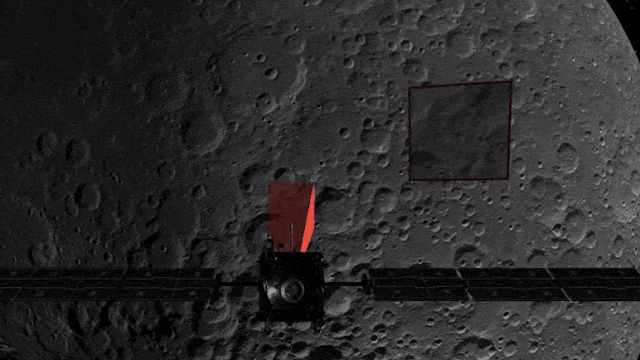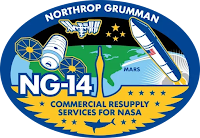NASA - NEOWISE Mission logo.
October 2, 2020
Matter swirling around supermassive black holes creates bursts of light that "echo" in nearby dust clouds. These traveling signals could serve as a new cosmic yardstick.

Animation above: A disk of hot material around a supermassive black hole emits a burst of visible light, which travels out to a ring of dust that subsequently emits infrared light. The blue arrows show the light from the disk moving toward the dust and the light from both events traveling toward an observer. Animation Credits: NASA/JPL-Caltech.
When you look up at the night sky, how do you know whether the specks of light that you see are bright and far away, or relatively faint and close by? One way to find out is to compare how much light the object actually emits with how bright it appears. The difference between its true luminosity and its apparent brightness reveals an object's distance from the observer.
Measuring the luminosity of a celestial object is challenging, especially with black holes, which don't emit light. But the supermassive black holes that lie at the center of most galaxies provide a loophole: They often pull lots of matter around them, forming hot disks that can radiate brightly. Measuring the luminosity of a bright disk would allow astronomers to gauge the distance to the black hole and the galaxy it lives in. Distance measurements not only help scientists create a better, three-dimensional map of the universe, they can also provide information about how and when objects formed.
In a new study, astronomers used a technique that some have nicknamed "echo mapping" to measure the luminosity of black hole disks in over 500 galaxies. Published last month in the Astrophysical Journal, the study adds support to the idea that this approach could be used to measure the distances between Earth and these faraway galaxies.
The process of echo mapping, also known as reverberation mapping, starts when the disk of hot plasma (atoms that have lost their electrons) close to the black hole gets brighter, sometimes even releasing short flares of visible light (meaning wavelengths that can be seen by the human eye). That light travels away from the disk and eventually runs into a common feature of most supermassive black hole systems: an enormous cloud of dust in the shape of a doughnut (also known as a torus). Together, the disk and the torus form a sort of bullseye, with the accretion disk wrapped tightly around the black hole, followed by consecutive rings of slightly cooler plasma and gas, and finally the dust torus, which makes up the widest, outermost ring in the bullseye. When the flash of light from the accretion disk reaches the inner wall of the dusty torus, the light gets absorbed, causing the dust to heat up and release infrared light. This brightening of the torus is a direct response to or, one might say an "echo" of the changes happening in the disk.
The distance from the accretion disk to the inside of the dust torus can be vast - billions or trillions of miles. Even light, traveling at 186,000 miles (300,000 kilometers) per second, can take months or years to cross it. If astronomers can observe both the initial flare of visible light in the accretion disk and the subsequent infrared brightening in the torus, they can also measure the time it took the light to travel between those two structures. Because light travels at a standard speed, this information also gives astronomers the distance between the disk and the torus.
Scientists can then use the distance measurement to calculate the disk's luminosity, and, in theory, its distance from Earth. Here's how: The temperature in the part of the disk closest to the black hole can reach tens of thousands of degrees - so high that even atoms are torn apart and dust particles can't form. The heat from the disk also warms the area around it, like a bonfire on a cold night. Traveling away from the black hole, the temperature decreases gradually.
Astronomers know that dust forms when the temperature dips to about 2,200 degrees Fahrenheit (1,200 Celsius); the bigger the bonfire (or the more energy the disk radiates), the farther away from it the dust forms. So measuring the distance between the accretion disk and the torus reveals the energy output of the disk, which is directly proportional to its luminosity.

Near Earth Object Wide Field Infrared Survey Explorer (NEOWISE). Image Credit: NASA
Because the light can take months or years to traverse the space between the disk and the torus, astronomers need data that spans decades. The new study relies on nearly two decades of visible-light observations of black hole accretion disks, captured by several ground-based telescopes. The infrared light emitted by the dust was detected by NASA's Near Earth Object Wide Field Infrared Survey Explorer (NEOWISE), previously named WISE. The spacecraft surveys the entire sky about once every six months, providing astronomers with repeated opportunities to observe galaxies and look for signs of those light "echoes." The study used 14 surveys of the sky by WISE/NEOWISE, collected between 2010 and 2019. In some galaxies, the light took more than 10 years to traverse the distance between the accretion disk and the dust, making them the longest echoes ever measured outside the Milky Way galaxy.
Galaxies Far, Far Away
The idea to use echo mapping to measure the distance from Earth to far away galaxies is not new, but the study makes substantial strides in demonstrating its feasibility. The largest single survey of its kind, the study confirms that echo mapping plays out in the same way in all galaxies, regardless of such variables as a black hole's size, which can vary significantly across the universe. But the technique isn't ready for prime time.
Due to multiple factors, the authors' distance measurements lack precision. Most notably, the authors said, they need to understand more about the structure of the inner regions of the dust doughnut encircling the black hole. That structure could affect such things as which specific wavelengths of infrared light the dust emits when the light first reaches it.
The WISE data doesn't span the entire infrared wavelength range, and a broader dataset could improve the distance measurements. NASA's Nancy Grace Roman Space Telescope, set to launch in the mid-2020s, will provide targeted observations in different infrared wavelength ranges. The agency's upcoming SPHEREx mission (which stands for Spectro-Photometer for the History of the Universe, Epoch of Reionization and Ices Explorer) will survey the entire sky in multiple infrared wavelengths and could also help improve the technique.
"The beauty of the echo mapping technique is that these supermassive black holes aren't going away anytime soon," said Qian Yang, a researcher at the University of Illinois at Urbana-Champaign and lead author of the study, referring to the fact that black hole disks may experience active flaring for thousands or even millions of years. "So we can measure the dust echoes over and over again for the same system to improve the distance measurement."
Luminosity-based distance measurements can already be done with objects known as "standard candles," which have a known luminosity. One example is a type of exploding star called a Type 1a supernovas, which played a critical role in the discovery of dark energy (the name given to the mysterious driving force behind the universe's accelerating expansion). Type 1a supernovas all have about the same luminosity, so astronomers only need to measure their apparent brightness to calculate their distance from Earth.
With other standard candles, astronomers can measure a property of the object to deduce its specific luminosity. Such is the case with echo mapping, where each accretion disk is unique but the technique for measuring the luminosity is the same. There are benefits for astronomers to being able to use multiple standard candles, such as being able to compare distance measurements to confirm their accuracy, and each standard candle has strengths and weaknesses.
"Measuring cosmic distances is a fundamental challenge in astronomy, so the possibility of having an extra trick up one's sleeve is very exciting," said Yue Shen, also a researcher at the University of Illinois at Urbana-Champaign and co-author of the paper.
Launched in 2009, the WISE spacecraft was placed into hibernation in 2011 after completing its primary mission. In Sept. 2013, NASA reactivated the spacecraft with the primary goal of scanning for near-Earth objects, or NEOs, and the mission and spacecraft were renamed NEOWISE. NASA's Jet Propulsion Laboratory in Southern California managed and operated WISE for NASA's Science Mission Directorate. The mission was selected competitively under NASA's Explorers Program managed by the agency's Goddard Space Flight Center in Greenbelt, Maryland. NEOWISE is a project of JPL, a division of Caltech, and the University of Arizona, supported by NASA's Planetary Defense Coordination Office.
Related links:
Astrophysical Journal: https://ui.adsabs.harvard.edu/abs/2020ApJ...900...58Y/abstract
NASA's Near Earth Object Wide Field Infrared Survey Explorer (NEOWISE): https://www.nasa.gov/mission_pages/neowise/main/index.html
NASA's Nancy Grace Roman Space Telescope: https://roman.gsfc.nasa.gov/
SPHEREx mission: https://www.jpl.nasa.gov/missions/spherex/
Animation (mentioned), Image (mentioned), Text, Credits: NASA/JPL/Calla Cofield.
Greetings, Orbiter.ch












































